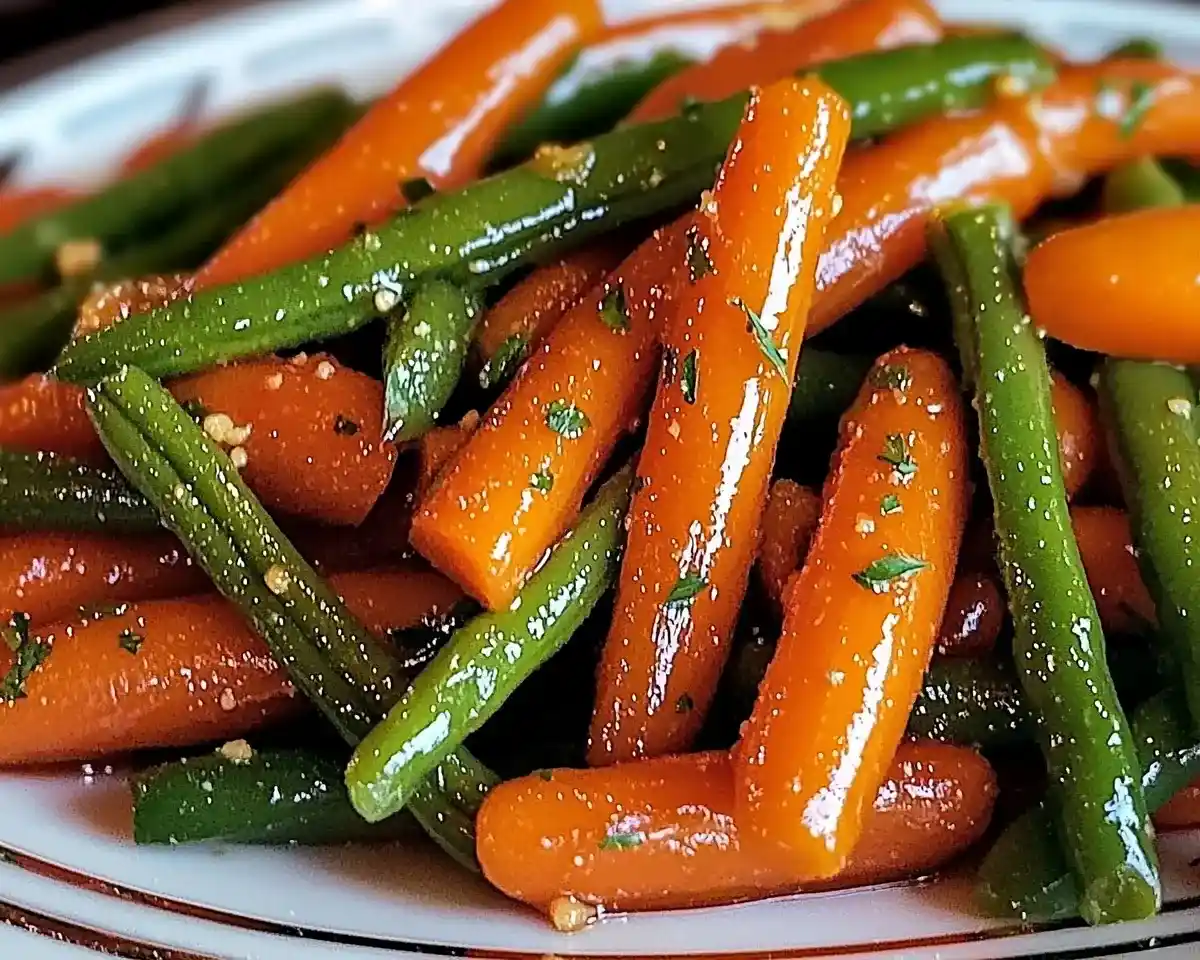Honey Glazed Carrots & Green Beans recipe delivers caramelized perfection. Perfect Thanksgiving veggies with balsamic and thyme in under 30 minutes.
Well… let me tell you about the time I almost ruined Thanksgiving dinner.
Picture this: my mother-in-law arriving in twenty minutes, the turkey still needs attention, and I’m standing there with a bag of plain carrots and green beans wondering how on earth I’d make them special.
You know that moment when panic meets creativity? That’s when this honey glazed carrots and green beans recipe was born.
One quick toss in honey and balsamic, twenty minutes in a hot oven, and suddenly I had a dish that looked like I’d spent hours on it. The vegetables emerged glistening and caramelized, sweet and tangy, with edges so crispy they practically sang. My mother-in-law asked for the recipe three times before dessert.
I’ve made this dish at least forty times since then. I’ve tweaked the honey ratio, experimented with different vinegars, and even burned a batch when I got distracted by football. But every single version has taught me something new about coaxing maximum flavor from simple vegetables.
Whether you’re planning your holiday menu or just trying to make Tuesday dinner feel special, this recipe transforms humble vegetables into something extraordinary. The magic happens when honey meets high heat, creating those caramelized edges that make even green bean skeptics reach for seconds.
Table of Contents
What Makes This Honey Glazed Vegetables Recipe Stand Out
This isn’t your typical steamed vegetable side dish. Instead, we’re roasting these vegetables at high heat to concentrate their natural sugars and create that irresistible caramelization.
The real secret lies in the glaze itself. Honey provides natural sweetness and helps create those golden, crispy edges. Meanwhile, balsamic vinegar cuts through the sweetness with a tangy depth that keeps each bite interesting. Garlic and thyme add savory complexity, transforming this from a simple side into a dish people actually crave.
I tested this recipe with everything from farmers’ market carrots to standard grocery store vegetables. The method works beautifully regardless of your source. However, fresher vegetables do deliver more vibrant color and snappier texture.
This recipe also solves a common holiday hosting problem: oven space. You can roast these vegetables alongside your main dish, and they require minimal attention. No constant stirring, no complicated techniques—just straightforward roasting that delivers maximum flavor.
Ingredient Table: Honey Glazed Carrots & Green Beans
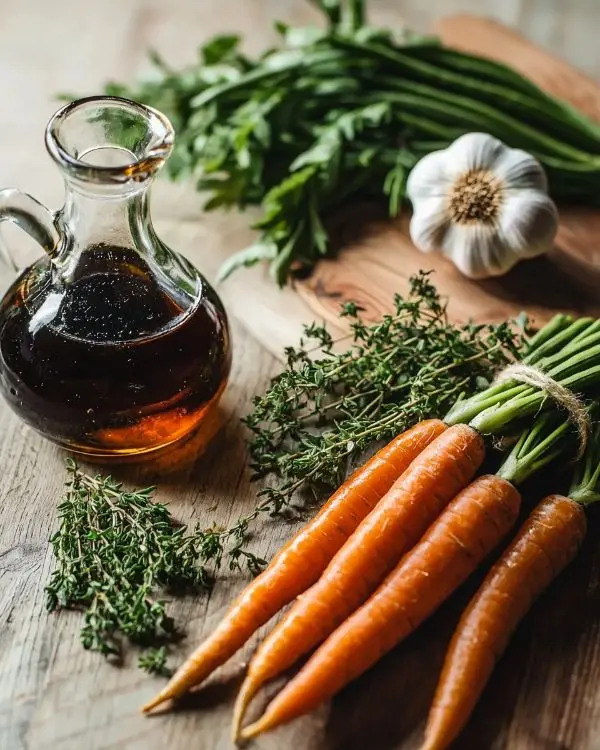
| Ingredient | US Measurement | Metric | Notes |
|---|---|---|---|
| Fresh carrots | 1 pound | 450g | Whole carrots preferred |
| Fresh green beans | 1 pound | 450g | Trim stem ends |
| Olive oil | 3 tablespoons | 45ml | Extra virgin recommended |
| Honey | 3 tablespoons | 45ml | Wildflower or local honey |
| Balsamic vinegar | 2 tablespoons | 30ml | Good quality matters |
| Garlic, minced | 2 cloves | 2 cloves | Fresh only |
| Dried thyme | 1 teaspoon | 1 teaspoon | Or 1 tbsp fresh |
| Salt | To taste | To taste | Kosher or sea salt |
| Black pepper | To taste | To taste | Freshly ground |
| Optional garnish | As needed | As needed | Parsley or sesame seeds |
Shopping Smart for Your Thanksgiving Veggies Recipes
Walk down the produce aisle with confidence. For carrots, look for firm specimens with bright orange color and no soft spots. The greens at the top should be vibrant if still attached. Honestly? I usually grab whole carrots rather than baby carrots because they roast more evenly and taste sweeter.
Green beans should snap crisply when you bend them. Avoid any that feel rubbery or show brown spots. French green beans (haricots verts) work beautifully here, though regular green beans deliver fantastic results too.
Most US grocery stores stock good honey year-round. Local honey from farmers’ markets adds special flavor, though any quality honey works. Avoid artificial honey blends—they won’t caramelize properly.
Essentials You’ll Need
These ingredients form the foundation of your dish. Each component plays a specific role in building flavor and texture. The carrots provide earthy sweetness that intensifies during roasting. Green beans add a fresh, slightly grassy note that balances the richness.
Olive oil facilitates even roasting and helps vegetables caramelize. Honey creates the signature glaze and promotes browning. Balsamic vinegar provides acidity that brightens the entire dish.
Bold Add-Ins for Creative Variations
Want to make this green beans carrots recipe your own? Try substituting maple syrup for honey during fall months. Add a pinch of red pepper flakes for subtle heat. Fresh rosemary can replace thyme for a more robust herb flavor.
Some readers have requested substitutions for international cooking. Swap olive oil with avocado or grapeseed oil. Replace balsamic vinegar with apple cider vinegar plus a pinch of brown sugar. Use agave nectar instead of honey for a vegan-friendly version.
Equipment You’ll Need (Plus DIY Alternatives)
A large baking sheet is essential. I recommend a half-sheet pan (18×13 inches) which provides ample space for vegetables to roast without crowding. No half-sheet pan? Use your largest rimmed baking sheet or split the vegetables between two smaller pans.
You’ll need a small mixing bowl for the glaze and a large bowl for tossing vegetables. A whisk helps emulsify the glaze ingredients, though a fork works in a pinch.
A sharp knife and cutting board are necessary for prep work. Additionally, keep a spatula handy for serving. Parchment paper or a silicone baking mat can prevent sticking, though they’re optional if you use enough oil.
Thomas Keller emphasizes the importance of proper equipment for even cooking. However, you don’t need professional-grade tools to achieve restaurant-quality results at home.
How to Make the Best Honey Glazed Carrots & Green Beans
Prepare Your Vegetables for Even Cooking
Preheat your oven to 400°F (200°C). This temperature is crucial—it’s hot enough to caramelize but not so hot that vegetables burn before cooking through.
Wash and trim the green beans by snapping off the stem ends. If using whole carrots, peel them thoroughly and cut into 1-inch pieces on the diagonal. Diagonal cuts create more surface area for caramelization.
Size consistency matters tremendously here. When vegetables are similar sizes, they finish cooking simultaneously. Nobody wants crunchy carrots alongside mushy green beans.
Oops! I learned this lesson the hard way. During my third attempt, I cut carrots into thick chunks while leaving green beans whole. The beans shriveled while carrots remained raw in the center. Now I’m obsessive about uniform sizing.
Create the Perfect Honey Glaze
Grab your small bowl and whisk together olive oil, honey, balsamic vinegar, minced garlic, dried thyme, salt, and black pepper. Whisk vigorously until everything emulsifies into a cohesive glaze.
The glaze should look slightly thickened and well combined. Taste it now—yes, straight from the bowl. This is your chance to adjust seasonings before vegetables hit the oven.
Julia Child always advocated for tasting as you cook. She understood that cooking is about adjusting flavors to your preference, not blindly following measurements. If you prefer more tang, add another splash of vinegar. Want extra sweetness? Drizzle in more honey.
This glaze also works brilliantly on other roasted vegetables. I’ve used it successfully on Brussels sprouts, sweet potatoes, and even butternut squash. Consider making a double batch and storing extra in the refrigerator for quick weeknight dinners.
Coat Vegetables Thoroughly for Maximum Flavor
Transfer prepared carrots and green beans to your large bowl. Pour the honey glaze over top and toss everything together enthusiastically.
Use your hands—seriously. Clean hands are the best tools for ensuring every vegetable piece gets completely coated. You want each carrot and bean glistening with glaze.
This step determines how much caramelization you’ll achieve. Any bare spots will roast differently than glazed areas. Spend an extra minute here coating thoroughly, and you’ll notice the difference in your final dish.
Arrange for Optimal Roasting
Spread glazed vegetables in a single layer across your baking sheet. This is absolutely critical—overcrowding causes steaming instead of roasting.
Vegetables need breathing room. When they touch excessively, moisture gets trapped and prevents proper caramelization. If your baking sheet looks crowded, grab a second sheet and split the vegetables between them.
Man, oh man, this made such a difference when I finally figured it out. My early attempts resulted in soggy vegetables because I crammed everything onto one pan. Now I always use two sheets if needed, and the results are consistently excellent.
Monitor Roasting Time Carefully
Slide your baking sheet into the preheated oven and set a timer for 20 minutes. The vegetables will roast for 20-25 minutes total, but checking early prevents overcooking.
Around the 20-minute mark, peek inside. Carrots should be tender when pierced with a fork. Green beans should maintain a slight snap while turning bright green. The glaze will have reduced and started caramelizing around the edges.
Does everything look perfect? Pull them out. Need more time? Give them another 3-5 minutes. Oven temperatures vary, so trust your senses over the clock.
Achieve Restaurant-Quality Caramelization
Want those deeply caramelized edges that make vegetables irresistible? Switch your oven to broil for the final 1-2 minutes.
Stay right there watching through the oven window. Honey can go from perfectly caramelized to burned in seconds under the broiler. I’m talking maybe 30 seconds difference between gorgeous and ruined.
This optional step creates those crispy, almost candy-like edges that make people ask what your secret is. The intense heat concentrates flavors and creates textural contrast between tender interiors and crispy exteriors.
Rest Before Serving
Remove the baking sheet from the oven and let vegetables rest for 1-2 minutes. This brief resting period allows the glaze to thicken slightly and cling better to the vegetables.
Transfer to a serving platter and garnish with chopped fresh parsley or toasted sesame seeds if desired. The parsley adds a fresh, herbaceous note while sesame seeds contribute nutty crunch.
Serve immediately while still warm. These vegetables are best enjoyed fresh from the oven when the glaze is still slightly syrupy and the edges are at peak crispiness.
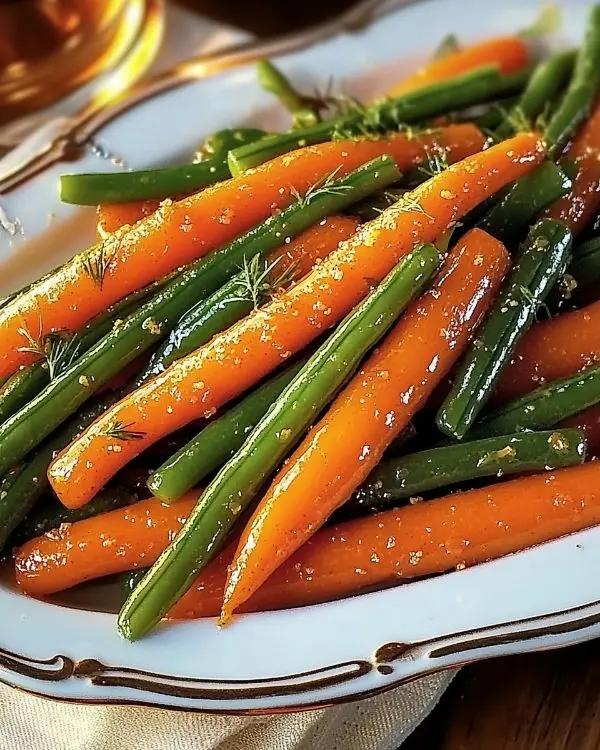
Expert Tips for Consistently Excellent Results
Temperature precision matters. If your oven runs hot or cool, adjust accordingly. An oven thermometer costs about ten dollars and eliminates guesswork.
Don’t skip the diagonal cut on carrots. This technique increases surface area dramatically, which means more caramelization and better flavor in every bite.
Fresh garlic is non-negotiable here. Pre-minced garlic from a jar contains preservatives that can taste bitter when roasted. Spend the extra minute mincing fresh cloves—your vegetables will thank you.
Consider blanching green beans briefly before roasting if you prefer them very tender. Drop them in boiling water for exactly 2 minutes, then immediately plunge into ice water. This technique brightens their color and ensures they’ll be perfectly tender after roasting.
Creative Variations for Every Season
Southern-Style Honey Glazed Vegetables
Add 2 tablespoons of bourbon to your glaze along with a tablespoon of Dijon mustard. The bourbon adds depth while the mustard provides sharp contrast to the honey’s sweetness. This variation pairs beautifully with grilled meats and works especially well for summer cookouts.
Holiday Spiced Version
Mix 1/2 teaspoon each of cinnamon and nutmeg into your glaze. This transforms the dish into perfect Thanksgiving veggies recipes that complement turkey and stuffing beautifully. The warming spices echo traditional holiday flavors while keeping vegetables as the star.
Asian-Inspired Glaze
Replace balsamic vinegar with rice vinegar and add 1 tablespoon of soy sauce. Swap thyme for fresh ginger. Garnish with toasted sesame seeds and sliced green onions. This version makes excellent vegetable for potluck events with diverse flavor preferences.
Spicy Maple Variation
Substitute maple syrup for honey and add 1/4 teaspoon of cayenne pepper. The maple provides deeper, more complex sweetness while cayenne adds pleasant heat that builds gradually. This combination works especially well during fall and winter months.
Mediterranean Style
Add 2 tablespoons of lemon juice to your glaze and increase garlic to 4 cloves. Finish with crumbled feta cheese and chopped fresh oregano. The bright acidity and salty cheese create an entirely different flavor profile that pairs wonderfully with grilled fish or chicken.
Storage and Make-Ahead Strategies
These vegetables taste best fresh from the oven. However, sometimes life requires advance preparation. You can prep everything up to 24 hours ahead—just keep vegetables and glaze separate in the refrigerator until ready to roast.
Leftover honey glazed carrots and green beans will keep refrigerated for up to 3 days in an airtight container. Reheat them in a 350°F oven for about 10 minutes. Alternatively, reheat them in a skillet over medium heat, which can restore some of the caramelized texture.
Green Beans Carrots Storage Guide
| Storage Method | Duration | Best Practices |
|---|---|---|
| Room temperature | 2 hours maximum | Keep covered loosely |
| Refrigerated | 3-4 days | Airtight container |
| Frozen | Not recommended | Texture suffers significantly |
| Prepped (uncooked) | 24 hours | Keep glaze separate |
Freezing isn’t ideal for these vegetables. The high water content in green beans causes them to become mushy when thawed. The glaze also separates and doesn’t reincorporate well. If you must freeze, expect compromised texture upon reheating.
Perfect Pairings for Your Holiday Table
This dish shines alongside roasted meats, particularly turkey, ham, or roast beef. The vegetables’ sweetness complements savory proteins beautifully while their acidity cuts through rich flavors.
For a complete holiday spread, serve these vegetables with Italian Christmas cookies for dessert. The cookies’ almond flavor pairs surprisingly well with the meal’s savory components.
Consider offering these vegetables at your next potluck gathering. They transport well, reheat easily, and appeal to most dietary preferences. They’re also visually stunning, which matters when your dish competes with dozens of others on a buffet table.
Looking for complementary sides? These vegetables pair excellently with colorful sprinkles Italian cookies for festive occasions. The sweet-savory contrast creates an interesting flavor progression throughout your meal.
For a lighter accompaniment, try serving these vegetables alongside tomato soup recipe using juice. The soup’s acidity and richness complement the vegetables’ sweetness beautifully. This combination works particularly well for casual weekend lunches.
Honey Glazed Carrots & Green Beans FAQs
Can you use honey to glaze carrots?
Absolutely—honey is actually one of the best glazing agents for carrots because it caramelizes beautifully at high temperatures while enhancing the carrots’ natural sweetness, and the sticky consistency helps the glaze adhere perfectly to the vegetable surface.
How to glaze carrots and green beans?
Toss the vegetables with a mixture of honey, olive oil, balsamic vinegar, and seasonings, then roast them at 400°F for 20-25 minutes until tender and caramelized, stirring once halfway through if desired for even coating.
Can I eat carrot and honey together?
Yes, carrots and honey pair wonderfully together as the honey amplifies carrots’ natural sweetness while adding complexity, and this combination has been enjoyed in various cuisines for centuries due to their complementary flavor profiles and nutritional benefits.
Does honey taste good on green beans?
Honey creates an excellent sweet-savory balance on green beans, especially when combined with acidic ingredients like balsamic vinegar and savory elements like garlic, which prevents the dish from becoming too sweet while highlighting the beans’ fresh, vegetal qualities.
Final Thoughts on This Crowd-Pleasing Side Dish
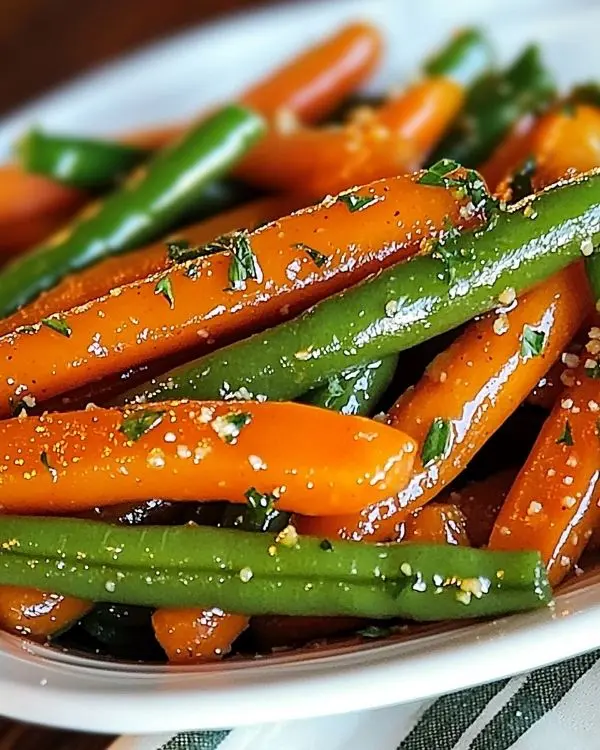
Remember that panic-induced Thanksgiving when this recipe was born? Now it’s become my most-requested dish. Friends specifically ask if I’m bringing “those vegetables” to gatherings. My niece, who claimed to hate green beans, now asks for them at every family dinner.
The beauty of this honey glazed carrots and green beans recipe lies in its simplicity. You’re not mastering complicated techniques or hunting down rare ingredients. Instead, you’re learning how heat, sweetness, and acid work together to transform everyday vegetables into something memorable.
Whether you’re planning Thanksgiving veggies recipes or just trying to convince kids that vegetables can taste amazing, this dish delivers. The caramelized edges satisfy everyone’s craving for something slightly indulgent, while the vegetables themselves provide nutrition and vibrant color.
Try this recipe this weekend. Serve it alongside your favorite protein or make it the star of a vegetarian meal. Adjust the sweetness to your preference. Add different herbs or spices. Make it yours.
Then come back and tell me how it went. Did your family reach for seconds? Did the vegetables disappear before the main course? I’d love to hear about your experience.
For more sweet treats to round out your meal, explore gluten-free Crumbl sugar cookies or dairy-free sugar cookies for guests with dietary restrictions.
Serve these vegetables with a crisp white wine or sparkling cider. The acidity in both beverages complements the honey glaze beautifully while cleansing your palate between bites.
Here’s to making vegetables the most exciting thing on your plate. Because at Tasty at Home, we believe every dish—even simple roasted vegetables—deserves to tell a delicious story.
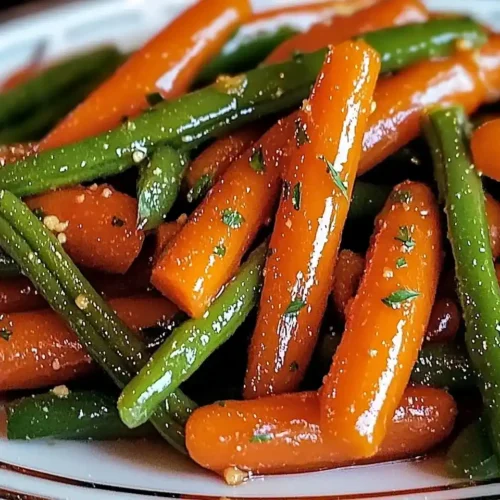
Honey Glazed Carrots & Green Beans
Equipment
- Baking sheet
- Mixing bowl
- Whisk
- Knife
- Cutting board
- spatula
Ingredients
Main Ingredients
- 1 pound Fresh carrots Whole carrots preferred
- 1 pound Fresh green beans Trim stem ends
- 3 tablespoons Olive oil Extra virgin recommended
- 3 tablespoons Honey Wildflower or local honey
- 2 tablespoons Balsamic vinegar Good quality matters
- 2 cloves Garlic, minced Fresh only
- 1 teaspoon Dried thyme Or 1 tbsp fresh
- To taste Salt Kosher or sea salt
- To taste Black pepper Freshly ground
- As needed Optional garnish Parsley or sesame seeds
Instructions
- Preheat oven to 400°F (200°C). Wash and trim green beans; peel and cut carrots into 1-inch diagonal pieces.
- In a small bowl, whisk together olive oil, honey, balsamic vinegar, garlic, thyme, salt, and black pepper to make the glaze.
- Transfer vegetables to a large bowl, pour the glaze over, and toss thoroughly to coat each piece.
- Spread vegetables in a single layer on a baking sheet. Roast for 20-25 minutes, stirring once halfway, until tender and caramelized.
- Optional: Broil for 1-2 minutes to achieve deeply caramelized edges, watching closely to prevent burning.
- Remove from oven, let rest 1-2 minutes, transfer to a serving platter, garnish, and serve warm.

